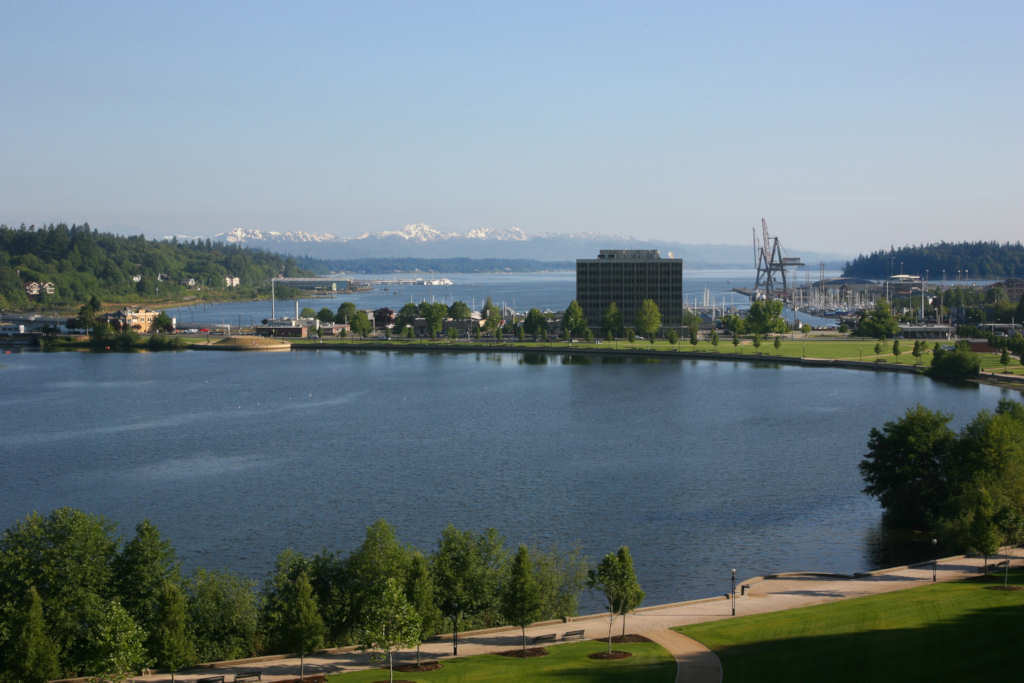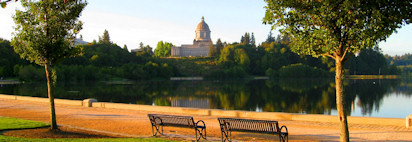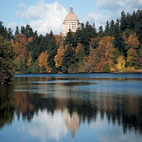Dredging & Sediment Cost Review
Prepared by Don Melnick and Bob Holman - July, 2011
As requested, we have completed our initial review of the CLAMP documents related to the dredging requirements for the various alternatives for the Capitol Lake Basin. This memo will outline our major concerns and suggest further work that could be done to evaluate these concerns.
First, however, we must make a disclaimer.
The CLAMP study spanned a period of seven years, at a cost of over $1.7 million, utilizing technical experts in many areas, to develop the analysis of the alternatives for Capitol Lake. Our respective engineering backgrounds and knowledge of the local area have provided the basis for our review and analysis, but we make no claim to be expert in any of the specific areas studied.
We are not in a position to question the technical analysis by the engineers and scientists utilized by CLAMP. Rather, we see our value as being able to “step back” and look at the overall conclusions, and see if they make sense today.
CONCERNS
Our primary objective was to look at dredging, but our review also took us into some related areas, which generated some additional comments. Our concerns fall into four general categories:
- Questionable assumptions
- Inconsistent approaches to the alternatives
- Errors in calculations
- Changes in conditions since study completion
#1 - Questionable assumptions
- Volume and depth of lake dredging necessary for the lake option was based on:
- Regaining flood storage lost due to sedimentation 1. Note: even with a dredge of 875,000 cubic yards (25 years of sediment at 35,000 cubic yards per year) this would represent about 90 minutes of storage under typical flood conditions (4000 cfs). This same 90 minutes of flood storage could be obtained by lowering the lake level 2 feet before the flood and letting the level rise.
- Safe water depth for operating ski boats on the lake
- Greater water depth to control weeds
- Amount of dredge spoils required to be sent offsite
- Inclusion of the costs of the 3 year initial dredge in Budd Inlet for the estuary option in long-term maintenance costs instead of making it part of the initial cost.
- The marinas, yacht club, Percival Landing and the Port Marine Terminal would be able to continue operations with a dredging cycle of ten years, which is estimated to result in a sediment depth increasing to over 6 feet by the end each cycle 2
- For the estuary option equilibrium conditions, estimated at 10 to 15 years, no sediment will deposit in the north or middle basins, 70 percent of the annual sediment will deposit in Budd Inlet, including the Port Facilities, Marinas, Yacht Club and Percival Landing, 3 and the remaining 30 percent will therefore be carried out of Lower Budd Inlet. However, most sediment enters Capitol Lake during storm events (estimate is 80-85 percent during 8 percent of the time). Under the estuary option, if this high sediment flow occurs at or near high tide, we would expect a significant amount to deposit more or less uniformly in the north and middle basins. The material that deposits in areas other than the main channel would likely remain there, and would eventually need to be dredged. This impacts the CLAMP study in several ways:
- It is at odds with the assumption regarding equilibrium conditions, i.e. no sedimentation in the basins
- The cost of this additional dredging is not considered
- The impact on the sediment ecosystem from periodic dredging in the mud flat area may be significant in light of the relatively long time it takes to establish the ecosystem equilibrium.
- To replace the Fifth Avenue Bridge for the estuary option, the CLAMP study called for a standard WSDOT precast, concrete girder bridge, commonly referred to as a “Freeway Bridge” 4. Their estimated cost for the Fifth Avenue Corridor improvements, including the bridge, is $22 million 5. The actual cost of the recently completed Fourth Avenue Bridge Project was in excess of $37 million 6. It is unlikely that the community will accept an architecturally inferior design, and therefore a more realistic cost should be included for comparison purposes. The CLAMP Study, Fact Sheet #5 7, discussed the issue of an aesthetically consistent design, but the costs and detailed description do not support this position.
#2 - Inconsistent approaches to the alternatives
- Budd Inlet (estuary option) dredging costs in the Final Report 8 are developed from comparisons with other Puget Sound port dredging 9, while the alternative Estuary and Capitol Lake dredging costs are built up from equipment and operational estimates 10. This results in a different dredging cost basis for the various alternatives, locations and scenarios.
- Most CLAMP Lake scenarios assume total off-site disposal of dredge spoils (at $62 - $136 per cubic yard)11 while the Estuary scenarios assume near shore disposal of lake dredging spoils (at $27-$55 per cubic yard)12. The dredge spoils are exactly the same material in either option.
- The estuary option assumes that a total of 394,000 cubic yards of dredge spoils can be placed near shore during the initial pre-dredge13, but that even under the most favorable conditions for the Lake option; only 100,000 cubic yards can be deposited near shore14.
- The cost for the Lake option for initial dredging of 100,000 cubic yards to a Budd Inlet restoration site is $5 million, or $50 per cubic yard 15 (corrected to $4 million, $40 per cubic yard- see next section). The cost for the Estuary option for dredging 394,000 cubic yards from the north and middle basins to a nearshore restoration is $10.8 million, or $27 per cubic yard 16.
- Additional enhancements, and additional costs, are considered a part of the Lake option, but not the Estuary option. An example is the additional dredging to allow water skiing.
#3 - Errors in calculations
- For the Lake option, the dredging costs are mistakenly inflated by 20% due to an error in tabulating unit costs. This occurs in Table 1 of the CLAMP Study, Dredging and Disposal Addendum 17.
- Under the dredging costs for the hydraulic dredge and the tender tug, the Total Daily Cost extensions in the right column are incorrect. They should be one-half of the totals shown. As a result, the total daily dredging cost drops to $11,900 (from $20,600).
- When the correct number is then used in Table 2, the total construction cost drops to $2.9 million (from $3.6 million) and the total cost drops to $4.0 million (from $5.0 million). Using the CLAMP study amount of 100,000 cubic yards, this changes the cost per cubic yard to $40 (from $50).
#4 - Changes in conditions since study completion
- Purple loosestrife may no longer be a problem for disposal of dredge spoils
- The TransAlta disposal site may no longer be a long term alternative, as they are required to discontinue using coal, and will likely switch to natural gas in the next few years. Note: this was probably not a cost effective alternative, anyway, because the unit costs are estimated to be about 65 percent higher at TransAlta 18.
- Recently found dioxin levels in Budd Inlet may affect the location and cost of disposal of dredge spoils for the Estuary option.
CONCLUSIONS AND RECOMMENDED FURTHER WORK
Addressing these identified concerns, and making appropriate corrections, has the potential to significantly change many of the conclusions regarding the relative costs of dredging for the CLAMP alternatives.
At the risk of advocating more study, one alternative that we suggest is hiring a nationally recognized independent engineering consultant to do a peer review of just the dredging and capital improvement issues, and then develop revised cost estimates for the two most likely options, which are:
- Maintaining the lake, with an initial dredge and periodic maintenance dredges
- Establishing an estuary, by removing the dam, building a new Fifth Avenue bridge, replacing the pedestrian walkway and railroad bridge to widen the Marathon Park constriction, and performing a North and Middle Basin pre-dredge, a three-year Budd Inlet initial dredge and periodic Budd Inlet and estuary maintenance dredges. This is Alternative B of the Estuary Feasibility Study, Phase 3 19.
Our reasoning for the need for a more objective independent review and analysis is that the CLAMP studies took place over a very long period of time and, though done by competent consultants, seem to have been driven by a less than objective panel of agency representatives who established much of the study criteria. Our review indicates that the panel apparently had a bias for creating an estuary, rather than assuring that an objective assessment of the two alternatives be conducted.
We are convinced, based on our preliminary review of the CLAMP process, that the results of the type of independent study we are recommending would greatly favor the Lake option. We suggest approaching the Port of Olympia for assistance with funding a study such as this. Our reasoning is that if the Estuary option were to prevail, a significant portion of the dredging costs in Budd Inlet could become the responsibility of the Port. Additionally, the responsibility for permitting, dredging and disposal logistics, and public outreach could also fall to the Port.
Although the current economic climate does not favor making any decision in the near future involving significant State funds, having a study such as this available, when needed, could provide a counterpoint to the CLAMP study conclusions. Commissioning such a study sooner, rather than later, would provide CLIPA and the Port with sound information that could be used initially to educate the public, and ultimately as a basis for offering more credible testimony during legislative funding hearings.
A potential additional funding source could be the City of Olympia. Like the Port, they have much to gain or lose depending on the option that prevails. Some of the City issues include the impact on the Percival Landing upgrade, the economic impact on the marinas and yacht club, the overall impact on tourism and recreation in the downtown area and the possibility of a less desirable bridge in the Fifth Avenue corridor.
REFERENCES & APPENDICES
All of the Appendix pages are from the CLAMP Study, and are either pages from the various Moffatt & Nichol reports that are part of the study, or are CLAMP Fact Sheets that are also part of the overall study documents.
1 Moffatt & Nichol 2008. Capitol Lake Alternatives Analysis Dredging and Disposal. Section 5.1.1, page 25 Appendix 01
2 CLAMP Fact Sheet #4, page 3 of 4 Appendix 02
3 Moffatt & Nichol 2009. Capitol Lake Alternatives Analysis Dredging and Disposal Addendum. Section 5.3.3, page 25 Appendix 03
4 Moffatt & Nichol 2007. Deschutes Estuary Feasibility Study, Phase 3, Engineering Design and Cost Estimates, Final Report. Section 3.2, Figure 2, page 10 Appendix 04
5 Moffatt & Nichol 2007. Deschutes Estuary Feasibility Study, Phase 3, Engineering Design and Cost Estimates, Final Report. Section 6, Table 5, page 32 Appendix 05
6 City of Olympia Miscellaneous Reports, Active Projects Status Report as of May 31, 2011, page 209 – 4th/5th Avenue Corridor/Bridge Improvement Fund (322 & 317), Expenditures to 2011 of $37,215,541.
7 CLAMP Fact Sheet #5, page 2 of 4 Appendix 06
8 Moffatt & Nichol 2007. Deschutes Estuary Feasibility Study, Phase 3, Engineering Design and Cost Estimates, Final Report. Section 6, Table 8, page 36 Appendix 07
9 Moffatt & Nichol 2007. Deschutes Estuary Feasibility Study, Phase 3, Engineering Design and Cost Estimates, Final Report. Appendix E, page E-1 Appendix 08
10 Moffatt & Nichol 2009. Capitol Lake Alternatives Analysis Dredging and Disposal Addendum. Section 2.4, page 10 Appendix 09
11 Moffatt & Nichol 2009. Capitol Lake Alternatives Analysis Dredging and Disposal Addendum. Section 3.2, page 15 Appendix 10
12 Moffatt & Nichol 2009. Capitol Lake Alternatives Analysis Dredging and Disposal Addendum. Section 6.3, Table 14, page 33 Appendix 11
13 Moffatt & Nichol 2009. Capitol Lake Alternatives Analysis Dredging and Disposal Addendum. Section 6.3, Table 14, page 33 Appendix 11
14 Moffatt & Nichol 2009. Capitol Lake Alternatives Analysis Dredging and Disposal Addendum. Section 3, Table 6, page 16 Appendix 12
15 Moffatt & Nichol 2009. Capitol Lake Alternatives Analysis Dredging and Disposal Addendum. Section 2.4, page 10 Appendix 09
16 Moffatt & Nichol 2009. Capitol Lake Alternatives Analysis Dredging and Disposal Addendum. Section 6.3, Table 14, page 33 Appendix 11
17 Moffatt & Nichol 2009. Capitol Lake Alternatives Analysis Dredging and Disposal Addendum. Section 2.4, page 10 Appendix 09
18 Moffatt & Nichol 2009. Capitol Lake Alternatives Analysis Dredging and Disposal Addendum. Section 2.5, page 11 Appendix 13
19 CLAMP Fact Sheet #2, pages 1 and 2 Appendix 14 & 15
Authors
Robert E. Holman
Mr. Holman holds degrees from the University of Arizona and Cornell University. Mr. Holman's experience includes engineering management and analytical services for major corporations, and most recently for LOTT Watewater Alliance in Olympia, Wa. Please see the PDF version of this document for his extensive resumé.
Donald R. Melnick
Mr. Melnick holds degrees from Clarkson University and Syracuse University. Mr. Melnick has bee a practicing civil engineer in 4 states, and currently maintains a license in Washington. Mr. Melnick has been involved in the planning, permitting, design and construction of water resources, hydroelectric and nuclear power generation, and highway bridges as well. Please see the PDF version of this document for his extensive resumé.
Dredging & Sediment Cost Review
by: Don Melnick and Bob HolmanReview of the Capitol Lake Adaptive Management Plan "CLAMP" documents related to the dredging requirements for the various alternatives for the Capitol Lake Basin


